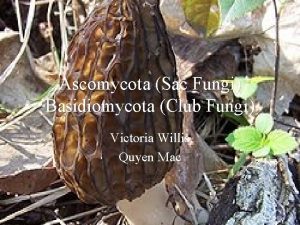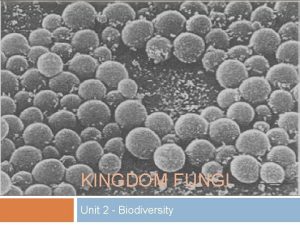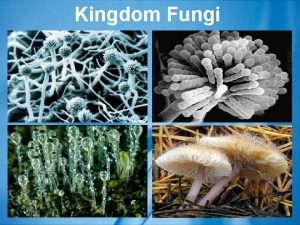Kingdom Fungi Fungi are rich and diverse groups


















- Slides: 18

Kingdom: Fungi

Fungi are rich and diverse groups of organisms on earth. The kingdom includes some of the most important organisms because of their important roles in human life, such as their beneficial and harmful effects on forests, their use in the pharmacology industry, and the mass production of cultivated fungi in the food industry, as well as their vital role in biodegradation. They include symbionts of plants, animals, or other fungi and also parasites. They have long been used as a direct source of human food, in the form of mushrooms and truffles; as a leavening agent for bread; and in the fermentation of various food products, such as wine, beer, and soy sauce.

Fungi have been used for the production of antibiotics cince 1940. Recently, various enzymes produced by fungi are used industrially and in detergents. They are also used as biological pesticides to control weeds, plant diseases and insect pests. Many species produce bioactive compounds called mycotoxins, such as alkaloids and polyketides, that are toxic to animals including humans. Approximately 100 000 species of fungi have been described; however, some estimates of total numbers suggest that 1. 5 million species may exist.

Fungi show a great diversity in morphology and habitat. They obtain their nutrients by absorption. Their cell walls are mostly made up of carbohydrate chitin, while the cell wall in plants is made of cellulose. The carbohydrates is stored in fungi as glycogen. Nutrition in fungi is by absorbing nutrients from the organic material in which they live. Fungi digest their food before it pass through the cell wall into the hyphae. The hyphae secrets enzymes and acids that break down the organic material into simple compounds. The kingdom fungi reproduce by means of spores Reproduction in fungi is both by sexual and asexual means. Sexual state is referred to as teleomorph, asexual state is referred to as anamorph.

The kingdom have a worldwide distribution, and they grow in a wide range of habitats such as deserts or areas with high salt concentrations or ionizing radiation as well as in deep sea sediments. ome can survive the intense UV and cosmic radiation encountered during space travel. Most grow in terrestrial environments, though several species live partly or solely in aquatic habitats, such as the chytrid fungus. Kingdom fungi is classified into four divisions (Chytridiomycota, Zygomycota, Ascomycota and Basidiomycota).

Division: Chytridiomycota

Chytridiomycota, also known as chytrids, is a division of zoosporic organisms in the kingdom Fungi. Members of the division occur mainly in aquatic or moist habitats where they live as parasites on plants, insects, or amphibians, while others are saprobes. Like other fungi, chytrids have chitin in their cell walls, but one group of chytrids has both cellulose and chitin in the cell wall. Most chytrids are unicellular; a few form multicellular organisms and hyphae, which have no septa between cells (coenocytic). They produce gametes and diploid zoospores that swim with the help of a single flagellum. About 750 described chytrid species are currently exist. Sexual reproduction of most Chytridiomycota members is not known. Asexual reproduction occurs through the release of zoospores derived through mitosis. Sexual reproduction is common among members of the Monoblepharidomycetes. They practice a version of oogamy: the male is motile and the female is stationary. This is the first occurrence of oogamy in kingdom Fungi

Systematics of Chytridiomycota Class: Blastocladiomycetes Order: Blastocladiales Fam: Blastocladiaceae Genus: Allomyces Genus: Blastocladia Genus: Microallomyces Genus: Septocladia Genus: Sphaerocladia Family: Coelomomycetaceae Genus: Coelomomyces Class: Chytridiomycetes Order: Chytridiales Class: Monoblepharidomycetes Order: Monoblepharidales Family: Monoblepharidaceae Genus: Diblepharis Genus: Monoblephariopsis Genus: Monoblepharis Class: Olpidiomycetes Order: Olpidiales Fam: Olpidiaceae Genus: Olpidium Class: Rhizophydiomycetes Order: Rhizophydiales Fam: Rhizophydiaceae Genus: Rhizophydium Class: Synchytriomycetes Ordo: Synchytriales Family: Synchytriaceae Genus: Synchytrium

Division: Zygomycota

Zygomycota members are characterized by primitive coenocytic hyphae. More than 1050 Zygomycota species are currently exist. They are mostly terrestrial in habitat, living in soil or on decaying plant or animal material. Some are parasites of plants, insects, and small animals, while others form symbiotic relationships with plants. Members of the division possess the ability to reproduce both sexually and asexually. Asexual spores include chlamydoconidia, conidia and sporangiospores contained in sporangia borne on simple or branched sporangiophores. Sexual reproduction is isogamous producing a thick-walled sexual resting spore called a zygospore.

Systematics of Zygomycota Two classes are recognized in this division; the Trichomycetes and Zygomycetes. Class: Zygomycetes Characteristics of the class is the same as those of the division. The class contains 6 orders, 29 families, 120 genera, approximately 800 species.

Order: Endogonales The order includes only one family, four genera and 27 species. Its members are distinguished by their production of small sporocarps that are eaten by rodents and distributed by their feces. Order: Entomophthorales Most members of the order are pathogens of insects. A few attack nematodes, mites, and tardigrades, and some are saprotrophs. Genus: Entomophthora Members of the genus are parasitic on flies and other twowinged insects.

Order: Kickxellales The order contains the single family and eight genus. Order: Mucorales, also known as pin molds, is the largest order of the class Zygomycetes. The order includes 13 families, 56 genera, 300 species. Most of its members are saprotrophic, and grow on organic substrates. Some species are parasites or pathogens of animals, plants and fungi. A few species cause human and animal disease zygomycosis, as well as allergic reactions.

Genus: Mucor Genus Mucor includes approximately 40 species. Most members have widespread occurrence and economic importance. Genus: Rhizopus Members of the genus are multicellular and they are common saprophytic fungi on plants and specialized parasites on animals. They are found on a wide variety of organic substrates such as fruits and vegetables, syrups, leather, bread, peanuts, and tobacco. Some Rhizopus members are commonly used in industrial processes. R. oryzae is useful for the production of lactic acid and cortisone, for alcoholic fermentation, R. stolonifer is used to produce fumaric acid, lactic acid, and cortisone, and R. delemar produces fumaric acid and biotin. Some Rhizopus species such as R. oligosporus and R. oryzae are important in some foods and traditional alcoholic beverages.

Order: Zoopagales The order includes 5 families, 22 genera, and 190 species Most members are parasites or predators of microscopic animals such as amoebae. They also prey on rotifers. The order includes 5 genus (Acaulopage, Bdellospora, Cystopage, Lecythispora, Stylopage, Zoopage and Zoophagus).

Class: Trichomycetes The class contains 4 orders, 7 families, 52 genera, about 210 species. Its members grow in the guts of arthropods living in aquatic habitats. They are generally viewed as commensals, having little effect on the host, but in stressful environments they might confer an advantage to colonized hosts; in some cases they act as pathogens Most Trichomycetes colonize freshwater and marine arthropods, but some colonize terrestrial arthropods.

Order: Harpellales Members of the order are obligate, symbiotic fungi that colonize the digestive tracts of ods, including black flies. Thalli of the order are either unbranched or branched, producing basipetal series of trichospores. Zygospores are biconical. Genus: Herpella The genus includes five species which grow in Diptera.

REFERENCES Beard CE. 2008 Trichomycetes. In: Capinera J. L. (eds) Encyclopedia of Entomology. Springer, Dordrecht Chinn RY, Diamond RD. 1982. "Generation of chemotactic factors by Rhizopus oryzae in the presence and absence of serum: relationship to hyphal damage mediated by human neutrophils and effects of hyperglycemia and ketoacidosis". Infection and Immunity. 38 (3): 1123– 29. Kirk PM, Cannon PF, Minter DW, Stalpers JA. 2008. Dictionary of the Fungi (10 th ed. ). Wallingford, UK: CABI. Zheng RY, Chen GQ, Huang H, Liu XY. 2007. A monograph of Rhizopus". Sydowia. 59 (2): 273– 372. Url 1. http: //www. tolweb. org/Zygomycota.
 Antigentest åre
Antigentest åre Cellular vs plasmodial slime molds
Cellular vs plasmodial slime molds Cool protists
Cool protists Share
Share Domain eukarya kingdom fungi
Domain eukarya kingdom fungi Old kingdom middle kingdom new kingdom
Old kingdom middle kingdom new kingdom Nnn ruled
Nnn ruled Old kingdom middle kingdom new kingdom
Old kingdom middle kingdom new kingdom Old kingdom middle kingdom new kingdom
Old kingdom middle kingdom new kingdom Pyrrophyta
Pyrrophyta Most diverse kingdom
Most diverse kingdom Sexual reproduction
Sexual reproduction How are ethnic groups and religious groups related
How are ethnic groups and religious groups related Odds and ends kingdom
Odds and ends kingdom Domain eukarya characteristics
Domain eukarya characteristics Seizing
Seizing Sac fungi and club fungi
Sac fungi and club fungi What is the main function of a fungus’s hyphae?
What is the main function of a fungus’s hyphae? Spores of fungi
Spores of fungi


































